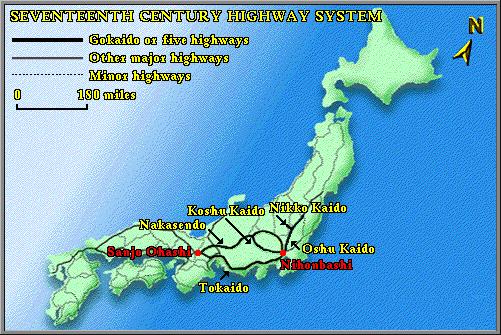Turning off the levee by the river, the Nakasendo enters Fukiage. Although Fukiage was a tateba, it was one of the places chosen to receive a train station on the Takasaki Line earlier this century. As a result, it has subsequently become a medium-sized town, well within commuting range of Tokyo.
After briefly joining the modern highway, the old Nakasendo branches off once more along a quiet suburban road. After a little more than a mile from Fukiage, a junction is passed. In the Edo period, the road from Edo forked here to offer an alternative route to Nikko, the site of the Tokugawa family’s mausoleum. Although this was not the official Nikko Road, this route offered daimyo who were attending the annual Nikko pilgrimage the chance to avoid using the same roads traveled by the shogun and other high officials. Eventually, almost ten miles from Kumagaya, the next post-town of Konosu is reached.

17th century Highway System
Typical of the last few post-towns on the way into Tokyo, where traffic along the highway was busiest in the Edo period, Konosu had a large proportion of inns, totaling 58 in 1843. Although the post-town has now achieved city status and straddles the modern highway, only one or two of the former inns continue to operate today.
Leaving Konosu, the Nakasendo becomes much busier with modern traffic than previously. The route follows an almost straight line, parallel to the railway, towards the heart of Tokyo. Although by-passed by a modern highway, the old road has been broadened to accommodate an unceasing flow of local traffic. The road is lined with industry and suburban housing creating a continuously built-up environment with high-rise concentrations around the train stations.
About two miles from Konosu, the former tateba of Kitamoto is reached.

